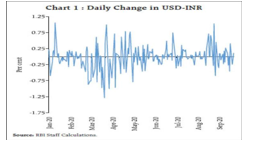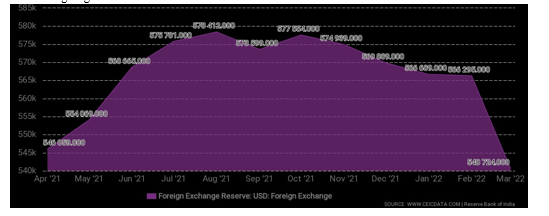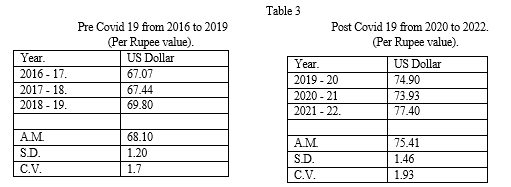Ijraset Journal For Research in Applied Science and Engineering Technology
- Home / Ijraset
- On This Page
- Abstract
- Introduction
- Conclusion
- References
- Copyright
Impact of COVID-19 on Indian Currency
Authors: Mr. Shravan
DOI Link: https://doi.org/10.22214/ijraset.2022.44718
Certificate: View Certificate
Abstract
In this article the author examines the impact of COVID -19 on Indian rupee. The data has been collected through secondary method such as RBI bulletin, newspapers and other research papers. The objectives of the study to investigate the impact of COVID -19 on Indian rupee, currency growth, FDI, export - import, economic stability in Indian economy and protection of Indian rupee against the U.S. dollar by making efficient economic policies. This paper cover the data of exchange rate from 2012 to 2022 to know the impact of corona. Further, this study observe the effect of Covid -19 on Indian currency by classifying the data into two categories like pre Covid -19 and post Covid -19. Pre Covid including the periods from 2012 -18 and post Covid including 2020 -22. The value of domestic currency declined in comparison to foreign currency, because the demand for foreign currency is more than domestic currency. Thus, the domestic rate of exchange increased and the value of domestic exports become cheaper than foreign imports. The study has used statistical measures such as: Arithmetic Mean (A.M.), Standard deviation {S.D.} and Coefficient of variance (C.V.).
Introduction
I. INTRODUCTION
Infectious disease has influenced the world from time to time , since the 20th century the world hit by various diseases like: Misnomer Spanish flu I.e., Influenza Pandemic 1918, Minnesota Smallpox epidemic (U.S.) 1924-25, Asian flu pandemic in South China 1957-58, Hong Kong flu pandemic 1968, Smallpox epidemic in India 1974. (Wei -Wei Zhang, Wang Dawei)
Similar disease began to emerge from the beginning of 21st century like, SARS 2002, Bird flu 2009, and Ebola 2014 and recently Covid -19 etc. (Wei Wei Zhang, Wang Dawei). In comparison to all the above disease, the Covid 19 influenced the world most.The novel Covid 19 corona virus destroyed the social and economic status of the global economy and India is part of global
Therefore, any change with world economy through COVID 19, will also impact the export - import,FDI, and exchange rate of Indian economy. This paper examines that Indian currency highly fluctuating comparison to the US dollar since covid-19. After covid19 the demand for US dollar is constantly increased by Indian govt. to face the economic instability that arise through Covid 19. Thus, the demand for dollar is growing but supply of dollar remain constant on the other side supply of Indian rupee rising still it demand constant,its resultant Indian rupee become cheaper than dollar.
On the basis of demand and supply currency can be classified in two categories: -
- Hard Currency: When the demand for foreign currency is more than its supply then it called hard currency for exp. US dollar, pound sterling, frank etc.
- Soft Currency: It including that the supply of currency is more than its demand. The rate of exchange for soft currency is higher than hard currency.
The main purpose of this paper is to examine the impact of covid 19 on the Indian currency researcher has collected the secondary data of exchange rate from RBI website and its bulletin. According RBI sources Indian rupee ishighly fluctuated comparison to the US dollar in the year of 2020, rupee fluctuation is shown by the following diagram.

Thus, the above diagram reflects that the Indian currency highly fluctuate in comparison to the US dollar from January to September in 2020. Depreciate in Indian rupee against the US dollar Influenced the export - import, foreign investment and inflation system in Indian economy. The overall result of this forex reserve declined in India, the data of forex reserve during 2021 - 22 is reflect in the following diagram

Thus, the above table shows that the Indian foreign reserve has dropped from mid-year 2021 to march 2022 due to the rise in the exchange rate. Since the year 2020 - 21 Indian currency highly fluctuating, the result of this India's foreign reserve declined from USD 577554 to USD 540724 in 2021-22.
II. REVIEW OF LITERATURE
Cheong et. al. (2005) investigated a link between fluctuating exchange rate, exports, and inflation. Author collected the sectoral data of export industries of UK. The author's results suggested that the unforeseen change in exchange rate make import more expensivethan export and trade volume reduced.Thereby, the result of reducing the volume of foreign trade and effected the risk level in the economy.
Goldberg (2009) examined that the foreign direct investment (FDI) of any economy is influenced by the regularly fluctuations in the exchange rate in the economy.
Grewal (2013) in his paper the author collected the data of exchange rate from 2008 to 2013, to know the impact of highly fluctuating in rupee value against the US dollar in 2013. This study revealed that various circumstances created in Indian economy due to variability in INR against the USD. The author's finding is that the rate of exchange during this period grow by near 50%, capital inflow decreased but outflow raised and widening the current a/c deficit.
Dr. Singh (2013) Singh 's article "Depreciation of Rupee in Indian Economy" , in this article Singh collected data of exchange rate from 1973 to 2012 to examined the volatility in Indian rupee in 2011 - 12.Author found that the exchange rate increased 52.8 in Dec.2011 from 44.8 in April. The decline in rupee value led to expensive imports which means economy face inflation crisis and result of it declined in country’s forexreserve. In this study, the author foundthe causes and intimation of rising exchange rate.
Arora (2014) examined that, the fall in the rupee to see the effect on the Indian economy on long time. The Indian economy has more suffered by loss due to decline in rupee. The depreciation in rupee compare to the dollar, it creates a new risk for economy. According to the author it is necessary for government and RBI to make the policy by attracting foreign institutional investment and grip on current account deficit.
Avahad (2016) this paper revealed the causes and effects of growing exchange rate on Indian economy. Author observed the data of exchange rate from 1947 to 1991, and finding are that, the decline in the rupee directly and indirectly effected toallsectors of the economy.The depreciation in INR value sharply influenced the forex reserve and FDI in country.
Garg &Singh (2018) know the impact of growing exchange rate on Indian economy in the year 2018, author collected the secondary data of exchange rate from 1973 to 2018. Authors finding revealed that the rupee value declined by 16% during 2018. Due to the declining in rupee value, current account deficit increased by 1.9% of GDP in 2018 while it was 0.6 in 2017 and a cut in forex reserve from 426 billion to 400 billion in the last of 2018.This study also explore that the growing exchange rate adversely influenced the export - import in Indian economy.
Janak Raj et.al. (2018) The disorder fluctuations in the exchange rate have negative impact on the trade, FDI and economic stability of a country.
Manjusha et al. (2020). This study examined that, the change in exchange rate is considered to be an important element of financial stress index (FSI) . That is negatively correlated with Index of industrial Production (IIP). result of this, exchange rate is animportant indicator of index of industrial production.
III. STATEMENT OF PROBLEM
When the demand for a currency is more than its supply, then the currency becomes expensive than other currency but when the supply of currency more than its demand, then the currency becomes less expensive. This paper explores that after Covid - 19 exchange rate sharply growing because of demand for the dollar becomes more than its supply, result of it that the dollar become more expensive than rupee. Thus, more expensive dollar impact on widening of current account deficit, rising of oil prices and decrease in foreign investment in India during pandemic raised the foreign capital outflow and decrease capital inflow. In the year 2018-19 current account deficit was US$ 4.6 billion (0.7% of GDP) but India’s current account deficit (CAD) increased to US$ 23.0 billion (2.7 per cent of GDP) in Q3:2021-22 from US$ 9.9 billion (1.3 per cent of GDP) in Q2:2021-22 and US$ 2.2 billion (0.3 per cent of GDP) a year ago (RBI bulletin). On the other side petrol and diesel prices are rising, in the year 2018 patrol and diesel price were Rs69.04 and Rs 63.09 a litre respectively while in April 2022 the prices of petrol and diesel are 105.41 and 96.67 rupee per litter (Economic Times). Hence, the present paper analyse the impact of COVID -19 on Indian currency against the US dollar and also know to impact on Indian economy. Further the study will present the recommendation to Indian govt. and central bank to overcome such factors.
IV. OBJECTIVE OF THE STUDY
The followings are main objective this study: -
- To compare the fluctuations in Indian rupee in Pre- and Post-Covid - 19.
- To find the fundamental causes of depreciation in Indian rupee against the US dollar.
- To analyse the impact of fluctuations in rupee on India's current account deficit.
- To recommendation fiscal and monetary policy required for government and central bank to curb on fluctuations in Indian currency.
V. RESEARCH METHODOLOGY
Research methodology is a technique which used for conducting research. R.M. describe the essence of data, technique of data collection and analysis of data. In present we used the secondary data which has been collected from RBI site, Bulletin, journals, newspapers and other research paper. This study covers the period of 10 years from 2012 to 2022. The collected data have been analysis by Arithmetic mean, Standard deviation and covariance.
VI. DATA ANALYSIS AND DISCUSSION
The data of the present paper can be classified in two categories I.e.
- Fluctuations in Indian Rupee value against the US dollar.
- Impact of growing exchange rate on Indian economy.
Part -|.Fluctuations in Rupee value against US dollar.
This part include the data of exchange rate of Indian rupee and US dollar for pre Covid - 19 from 2012 to 2018 and post Covid -19 from 2019 to 2022.
Table: - 1Depreciation in rupee value against US dollar of pre and post Covid - 19 from 2012 to 2022.
Pre Covid 19 from 2012 to 2018. (Per Rupee value).
|
Year |
US Dollar |
|
2012 - 13 |
54.40 |
|
2013 - 14 |
60.50 |
|
2014 - 15 |
61.14 |
|
2015 - 16 |
65.46 |
|
2016 - 17 |
67.07 |
|
2017 - 18 |
67.44 |
|
2018 - 19 |
69.80. |
http: // www.rbi.org.in
The above Table 1 reflect that during the period of 7 years (2012 to 19) before Covid 19 the exchange rate increased near about 2.1 points annually
Table :-2
Post Covid 19 from 2020 to 2022. ( Per Rupee value).
|
Year. |
US Dollar |
|
2019 - 20 |
74.90 |
|
2020 - 21 |
73.93 |
|
2021 - 22. |
77.40 |
http:// www.rbi.org.in
Table 2 shows that the exchange rate sharply increase during period of post Covid (2020 to 2022) it raised by 2.7 points which is higher than pre Covid 19. Now we do comparative studies of exchange rate for 3 years of Pre and post Covid -19 by using statistical tools.

Table-3 ravels that the growth of exchange rate compare from 2016 -19 to 2020- 22 and found that Arithmetic Mean (A.M.), Standard Deviation (S.D.) and Coefficient of Variance. (C.V.) of pre Covid period was 68.10, 1.20 and 1.7 respectively while post covid period A.M., S.D. and C.V. are 75.41, 1.46 and 1.93 which are higher than previous.
So, our finding isreflecting that after Covid the value of rupee sharply depreciated against dollar as compared to pre corona period.
VII. REASON OF CURRENT DEPRECIATION IN INR
- That federal reserve bank has increased its interest rate by which the loan of American investors has become costlier and the American investors started to withdraw investments from India, result of this outflow of foreign capital and FPI increase.
- Trade deficit of India is rising; imports are rising compare to export.
- Rising of crude oil prices due to decline in oil supplies.
- Sticky inflation presents in Indian economy, result of this foreign demand for Indian commodities are decrease.
Thus, all the above factors are responsible to falls in the value of Indian rupee.
Part - || Impact of Growing Exchange rate On Indian Economy.
Growth in exchange rate has adversely impact on Indian economy
• Widening the current account deficit, depleting the forex reserve and weakening the rupee value.
India’s current account deficit (CAD) increased to US$ 23.0 billion but it was US$ 2.2 billion a year ago [i.e., Q3:2020-21]. (RBI).
• Decrease in foreign direct investment result of it decline in capital inflow.
In the financial account, net foreign direct investment recorded an inflow of US$ 5.1 billion, lower than US$ 17.4 billion a year ago. (The Hindu)
• With higher landed crude oil price and other import induce to cost push inflation.
Besides the above negative impact, Indian economy occurs positivity through depleting in rupee because its exports become cheaper.
VIII. POLICY FOR IMPLICATION
In period of post- covid -19 Indian currency sharply depreciate compare to the US dollar.
So, in order to curb on volatility of exchange rate central government and RBI have required to formulate the policy to increase in the value of Indian rupee by control on trade deficit, regulate of export and import, raising import duty
and attracting foreign investment.
- The surplus dollar in the foreign reserve of RBI, should be supplied in the economy.
- The government has recently decided that the LIC IPO will opened in near future issue its share. Foreign investor's belief in this company, it will make possible to increase foreign investments.
- If OPEC (Organisation of Petroleum Exporting Country) increase the supply of crude oil then the price of crude oil will fall.
Thus, the government may be successful in appreciate of rupee value against dollar by applying the above decision.
Conclusion
Thus, the study shows an important relation among inflation, foreign investment, current account deficit, export - import and depreciate in rupee value with response to the US dollar for post - Covid 19 period. Due to depreciation in the value of rupee impact on capital inflow, FDI& Importare adversely affected. This led to widening of current account deficit, foreign capital outflow,inflation. The analysis of this paper concluded that Indian rupee value highly depreciated in period of post Covid - 19. Falling rupees have shown negative impact on the Indian economy. Thus, in order to improve the value of rupee the government of India and RBI should make the new economic policies, so that the situation before corona can be restored.
References
[1] C. Cheong, T Mehari, L.V. Williams Journal of Policy Modeling 27 (8), 2005.The Effects of Exchange Rate Volatility on Price Competitiveness and trade Volume in the UK: [2] Goldberg L.S. (2009), Exchange Rate and Foreign Direct investment. The Princeton encyclopedia of the world economy 1 (1), 393-396, 2009 [3] Dr. Singh P. (2013): Depreciation of Rupee In Indian Economy: An Analysis. International Journal of Innovation in Engineering and Technology (IJIET) Vol.2 [4] Grewal A. (2013): Impact of Rupee - Dollar Fluctuations on Indian Economy International Journal of Computer Science and Management Studies Vol.3 [5] Arora K. (2014): Depreciation of INR: Causes and Impact on Indian Economy. [6] AvahadS. (2016), Impact ofRupee Depreciationon Indian Economy Scholarly Research Journal for Interdisciplinary Studies Vol. -4/26 [7] Nidhi Garg &Dr.Shakti Singh :http://ijrar.com/ Rupee -Dollar fluctuationand Its ImpactonIndian Economy (2018) Vol.5 [8] Janka Raj (2018), Impact of Fluctuation in the Exchange Rate on Foreign trade and FDI. [9] Manjusha S. & Rajesh Kevdiya (2020), Negative Correlation with Index of Industrial Production (IIP) and Exchange rate http:/ www.rbi.org.in http:/ www.thehindu.com http:/ economictimes.indiatimes.com May 01, 2022
Copyright
Copyright © 2022 Mr. Shravan. This is an open access article distributed under the Creative Commons Attribution License, which permits unrestricted use, distribution, and reproduction in any medium, provided the original work is properly cited.

Download Paper
Paper Id : IJRASET44718
Publish Date : 2022-06-22
ISSN : 2321-9653
Publisher Name : IJRASET
DOI Link : Click Here
 Submit Paper Online
Submit Paper Online

